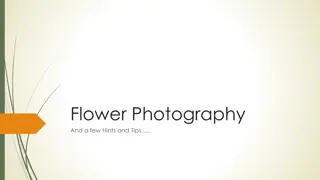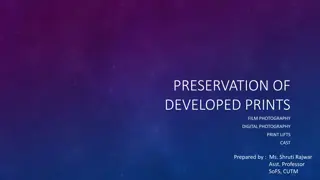Understanding Ethical Considerations in Manipulated Photography for Media
Ethical control in photojournalism involves capturing non-fiction events without manipulation, but some control over the image is acceptable within ethical bounds. However, moving into manipulated images for non-news events requires a different approach, involving subject and scene manipulation for illustration purposes. This article explores the distinction between passive manipulation in journalism and active manipulation in controlled images for feature stories, advertising, and public relations. It delves into subject manipulation by directing subjects and scene manipulation by controlling the environment to create photo illustrations that convey specific stories or concepts.
Download Presentation

Please find below an Image/Link to download the presentation.
The content on the website is provided AS IS for your information and personal use only. It may not be sold, licensed, or shared on other websites without obtaining consent from the author. Download presentation by click this link. If you encounter any issues during the download, it is possible that the publisher has removed the file from their server.
E N D
Presentation Transcript
Manipulated photography for mass media
Ethical beginnings Photojournalism is defined as non-fiction photography: people doing thing in a natural setting. We don t pose people. We don t control the situation. We attend an event, photograph what is there, try to portray fairly what we see.
Ethical control But even within this ideal, we consider some control over the image to be acceptable. We choose to photograph something in a certain way that we think fairly reflects the event. This is as a journalist writes using a certain angle. We control a photograph by what we include and leave out, either in the camera or later cropping. We control exposure, darkening, lightening, sharpening.
Ethical control Is this manipulation of the image? Yes. But it is passive manipulation: we are cropping and choosing angles, but we are not controlling the action of a scene. But what if you need to take a photo that s not part of a news story, or not even journalism? Then we move into the area of controlled, or manipulated images.
Controlled images You can provide manipulated images for a feature story. That is, a non-news event. This is a distortion for an illustration.
Two ways to manipulate Subject manipulation. Scene manipulation. Or both.
Subject manipulation You control your subject by asking that person to do something. The control may be casual: Just walk down the street as you usually do and I ll take your picture. Or the control may be more formal: Sit here, straight back, fingers on the keyboard, turn slightly my way, look toward the screen.
Scene manipulation You control the environment, including the background, objects and people in the scene, lighting of the scene. You may add an umbrella or hat for color, or an interesting background object to give context. You move things around.
Illustrations When you control the subject or environment, you create a photo illustration. That is, a photo to show a story, advertising or public relations concept. This does not mean the subject is formally posed. But it could. Within this idea we can make three separations: editorial photography, public relations photography and advertising photography.
Editorial illustrations In mass media this generally covers these areas: portraits; food; travel.
Portraits A portrait can be a mugshot. That is, a formal studio portrait. Or it can be an environmental portrait, an informal photo of someone doing something. In both cases, however, the subject is manipulated.
Lighting manipulation Usually in a manipulated portrait the lighting is also manipulated. Back light or fill light will give more uniform lighting than is usually available in the real world. In straight photojournalism we look for this lighting in our environment, and choose an angle to use it. In manipulated photography we can set up lights and use flash.
Manipulated portraits Usually we try to pose people so they appear natural. They don t necessarily look at the camera. Often, though, in an environmental portrait we feature a subject doing something he wouldn t really do very often. A classic example of this is the bank president or CEO sitting on the edge of a desk with his arms folded.
Food and travel Food shots are carefully manipulated to light the food in a way that makes it look appetizing. Travel feature photography may be less manipulated, but often people are posed doing things in an exotic environment, like splashing on the beach.
Public relations Public relations photography emphasizes persuasive images designed to reflect positively the person or group photographed. Corporate annual reports and press releases often feature this style of photojournalism.
Public relations Photojournalists usually have little say in setting up these photos. They are designed to reflect what the public relations director wants to portray.
Advertising Advertising photography is tightly controlled, and paid for by a client. It s usually not simple product photography. Most advertising photography tries to attach a lifestyle ideal to a product.
Advertising photography Products are shown in the most positive way possible. Cars look faster. Food looks better.
Control of advertising Advertising does have limits set by U.S. Trade Law. Beyond that, it s a question of ethics. How far can you go manipulating mass media photography for illustrations? The answer depends....
Boundaries You could do an illustration for, say, a story on meditation showing a composite image of someone in a dream world. But could you do an illustration for a story on politics using a composite image of a politician surrounded by starving children? Manipulation has ethical boundaries.
Good taste Manipulation also is bounded by the ethics of good taste. How about this to illustrate a feature looking at off-campus student Halloween parties?
Everyday manipulation The truth is most photography is manipulated to some extent. When we say smile in snaps we are manipulating our subject. When we turn on our flash we are manipulating the scene. How about some of the photos below. Manipulated? And if so, how?
Manipulated? Manipulated? How?
Manipulated? Manipulated? How?
Manipulated? Manipulated? How?
Manipulated? Manipulated? How?
Manipulated? Manipulated? How?
Manipulation Okay, now let s test our knowledge in the pro world of media photography. Fake or real? http://www.pbs.org/wgbh/nova/sciencenow/0301/03-for-01.html























